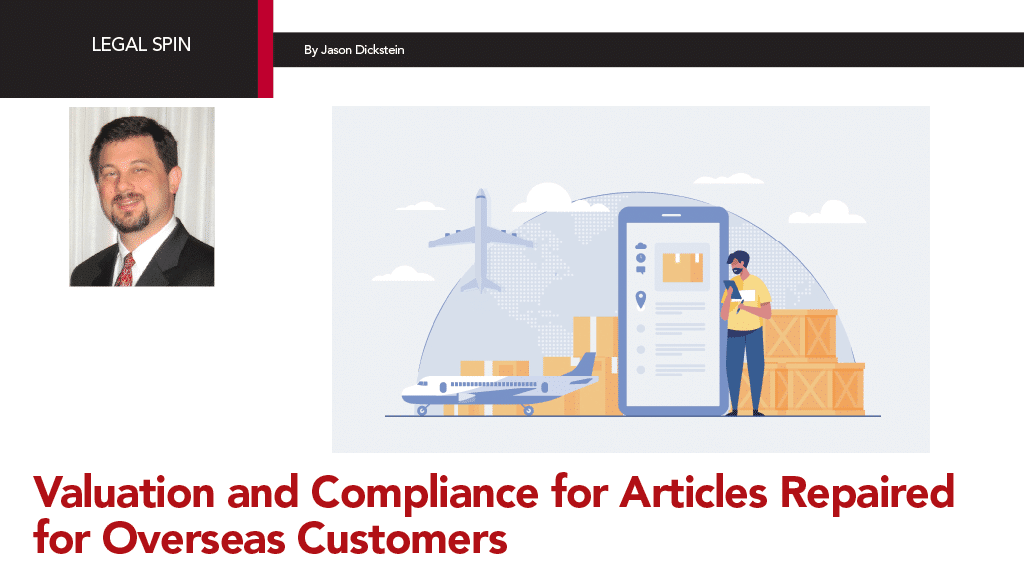When you repair an article in the United States from a customer outside of the United States, it presents some additional compliance challenges. In addition to the need to ensure you have the right certification and documentation to meet your customer’s needs, you also need to be concerned with U.S. export and import law. The shipment from your overseas customer to your U.S. facility is regulated as an import. When you return the article to your overseas customer, that is considered an export.
By following the formalities of import and export, you can help to make the entire process smoother. This article discusses some of the technical elements associated with accepting and subsequently returning a repaired article to your overseas customer.
Normally, when an article is imported into the United States it is declared on Customs Form 7501, Form 3311, or an electronic equivalent. The form is completed as part of the process of identifying the imported goods in order to declare their value so they can be taxed appropriately. Aviation industry importers often fail to pay much attention to this process because so many aircraft parts are subject to a zero percent import duty by default.
You will need to assess whether the article you intend to repair can be entered under informal entry provisions or under formal entry provisions.
Goods that are eligible for informal entry into the United States include those that are worth $2,500 or less. There is an important variation of this rule that applies to repair stations: informal entry also includes goods worth $10,000 or less when they meet two conditions: (1) it must be a product of the United States, (2) it must be imported for the purpose of repair or alteration prior to subsequent export. This will also apply to goods worth $10,000 or less that were imported after rejected or returned by the foreign purchaser to the United States.
Most aircraft parts being sent to the U.S. for repair are worth more than $2,500 so this means that most aircraft parts being imported for repair must be subject to formal entry, because they are not eligible for informal entry.
In a formal entry scenario, typically, your imported article should be accompanied by the following information:
• CBP Form 7501 (entry summary) or CBP Form 3311 (declaration of free entry for U.S. goods returned to the U.S.).
• A pro forma invoice including the statement of value.
• A packing list.
• Your name, street address, and importer identification number (assuming yours is the facility to which the article is to be delivered).
This is the information required to be provided for formal entry.
It is a good idea for repair stations to ensure that imports that may need to be returned under a license exception are properly declared upon entry. The reason for this is because it can ease the process of returning the articles.
If the article subject to repair is controlled under the International Traffic in Arms Regulations (ITARs), then the ITARs have a special exception to the normal license provisions that permits the article to be returned to the sender without a government license; however, to invoke this license exception the import documents need to identify that the article is being imported pursuant to 22 C.F.R. § 123.4.
Similarly, having access to properly completed import documentation can help you in your export process. For example, using the RPL license exception (for articles subject to repair or servicing in the U.S. and then returned abroad) requires the article in question to have been sent to the U.S. for servicing. If the import was declared under heading 9801 (for articles imported into the United States for repair and subsequent export), then this makes it easier to demonstrate that the subsequent export is subject to the RPL license exception (for parts imported and subsequently exported following repair or other servicing). Preparing for the worst is important — I once had a client who accepted an engine for repair. By the time the repair was finished, though, the U.S. regulations had changed with respect to the customer’s home country and the repair station needed a license to return the engine to the customer. The import documentation had been prepared inconsistent with the license exceptions.
The declaration on Customs Form 7501 will include a statement of the value of the article. This can help smooth the path for subsequent export of the repaired article after the maintenance is complete. The Electronic Export Information that must be filed for exporting most aircraft parts must include a value to meet census regulations. If the article has been repaired, then the value of the repair becomes the reported value, as long as the value of the article was declared in the original Form 7501 upon import. Depending on the customs rules of the customer’s country, this can also help your customer to assess accurate import duties.
What happens if you cannot repair the article? For example, the unit may be beyond economic repair, or you may quote the repair to your customer, and the customer may reject the repair price and ask for the unit to be returned. In that case, the article can be returned to the customer subject to normal export provisions, and the value to be reported on the Electronic Export Information will be the same as the import value that had been previously declared (e.g., on the Form 7501).
Please note that this is not an exhaustive discussion of the import and export provisions of the United States, and many provisions are omitted from this discussion. So, use this as a starting point for your compliance investigation but make sure you identify all of the relevant rules and chart your compliance path!
